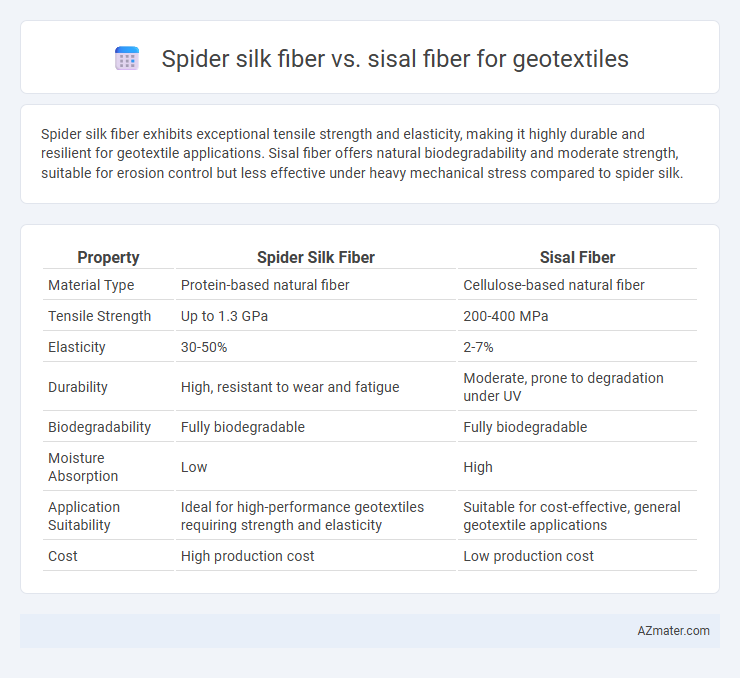Spider silk fiber exhibits exceptional tensile strength and elasticity, making it highly durable and resilient for geotextile applications. Sisal fiber offers natural biodegradability and moderate strength, suitable for erosion control but less effective under heavy mechanical stress compared to spider silk.
Table of Comparison
| Property | Spider Silk Fiber | Sisal Fiber |
|---|---|---|
| Material Type | Protein-based natural fiber | Cellulose-based natural fiber |
| Tensile Strength | Up to 1.3 GPa | 200-400 MPa |
| Elasticity | 30-50% | 2-7% |
| Durability | High, resistant to wear and fatigue | Moderate, prone to degradation under UV |
| Biodegradability | Fully biodegradable | Fully biodegradable |
| Moisture Absorption | Low | High |
| Application Suitability | Ideal for high-performance geotextiles requiring strength and elasticity | Suitable for cost-effective, general geotextile applications |
| Cost | High production cost | Low production cost |
Introduction to Geotextiles
Spider silk fiber and sisal fiber exhibit distinct properties that influence their suitability for geotextile applications, with spider silk offering exceptional tensile strength and elasticity due to its protein-based molecular structure, while sisal fiber, derived from the Agave plant, provides natural biodegradability and moderate durability. Geotextiles require materials that balance mechanical performance and environmental compatibility; spider silk's lightweight nature and superior strength make it ideal for reinforcement, whereas sisal's coarse texture and hydrophilic characteristics enhance soil stabilization and erosion control. The integration of these fibers into geotextile designs depends on specific project demands such as load-bearing capacity, lifespan, and ecological impact.
Overview of Spider Silk Fiber
Spider silk fiber exhibits exceptional tensile strength, elasticity, and biodegradability, making it a highly promising material for geotextile applications compared to conventional fibers like sisal. Its unique protein-based structure enables superior load-bearing capacity and resistance to environmental degradation, enhancing soil stabilization and erosion control. These properties position spider silk as an innovative, sustainable alternative in geotechnical engineering, though scalability and production cost currently limit widespread adoption.
Overview of Sisal Fiber
Sisal fiber, derived from the Agave sisalana plant, is a natural, biodegradable material widely used in geotextiles for soil stabilization and erosion control due to its high tensile strength and durability. Its coarse texture and resistance to saltwater make it suitable for reinforcement in coastal and agricultural applications, offering environmental benefits over synthetic alternatives. Compared to spider silk fiber, sisal is more readily available and cost-effective, although spider silk exhibits superior elasticity and tensile properties for specialized uses.
Mechanical Properties Comparison
Spider silk fiber exhibits exceptional tensile strength and elasticity, surpassing sisal fiber's mechanical properties, making it highly suitable for geotextile applications requiring durability and flexibility. While sisal fiber provides good abrasion resistance and moderate tensile strength, spider silk's superior toughness and energy absorption capacity enhance soil reinforcement and erosion control performance. The high modulus of elasticity and resilience of spider silk fiber contribute to longer-lasting, more efficient geotextile materials compared to the natural rigidity and lower strength of sisal fiber.
Durability and Longevity
Spider silk fiber exhibits exceptional durability and longevity for geotextile applications due to its high tensile strength, elasticity, and resistance to environmental degradation such as UV radiation and microbial attack. Sisal fiber, although biodegradable and moderately strong, degrades faster under harsh environmental conditions, limiting its lifespan compared to spider silk. The superior molecular structure of spider silk makes it ideal for long-term geotextile usage where strength retention and resilience are critical.
Environmental Impact and Sustainability
Spider silk fiber exhibits exceptional biodegradability and minimal ecological footprint compared to traditional sisal fiber, which, despite being natural, requires significant land and water resources for cultivation. The sustainable harvesting of spider silk, often through bioengineered production methods, reduces deforestation and soil degradation associated with sisal farming. Environmentally, spider silk fibers contribute to lower carbon emissions and enhanced soil conservation, positioning them as a superior sustainable alternative for geotextile applications.
Cost Analysis and Availability
Spider silk fiber exhibits superior tensile strength and biodegradability for geotextile applications but remains prohibitively expensive and limited in availability due to complex harvesting processes. Sisal fiber offers a cost-effective and widely available alternative with moderate durability and natural resistance to biodegradation, making it a practical choice for large-scale geotextile projects. Cost analysis reveals sisal's production expenses are significantly lower, enabling widespread use despite spider silk's enhanced mechanical properties.
Performance in Soil Reinforcement
Spider silk fiber exhibits exceptional tensile strength and elasticity, outperforming sisal fiber in soil reinforcement applications by providing superior load-bearing capacity and durability. The biocompatible and biodegradable nature of spider silk enhances soil stabilization without environmental degradation, while sisal fiber, though renewable, tends to degrade faster under microbial activity, reducing long-term reinforcement effectiveness. Spider silk's nanoscale fibrillar structure facilitates better soil particle bonding, resulting in enhanced erosion control and improved mechanical properties in geotextile performance.
Case Studies and Real-world Applications
Spider silk fiber exhibits exceptional tensile strength and elasticity, making it a promising biodegradable alternative for geotextile applications in erosion control and soil reinforcement, as demonstrated in case studies from coastal restoration projects. Sisal fiber, widely used in agricultural geotextiles, provides effective soil stabilization and moisture retention, validated by real-world applications in slope protection and road construction in tropical regions. Comparative studies highlight spider silk's superior durability under dynamic stress, while sisal's cost-effectiveness and availability remain advantageous for large-scale geotextile implementation.
Future Prospects and Innovations
Spider silk fiber exhibits exceptional tensile strength, elasticity, and biodegradability, positioning it as a promising material for future geotextile applications. Advances in bioengineering and synthetic production methods are driving innovations to scale spider silk fiber manufacturing, potentially reducing costs and enhancing material performance. Sisal fiber, while renewable and cost-effective, lacks the superior mechanical properties and biodegradability of spider silk, but hybrid composites combining both fibers could yield innovative, eco-friendly geotextile solutions with improved durability and environmental impact.

Infographic: Spider silk fiber vs Sisal fiber for Geotextile
 azmater.com
azmater.com